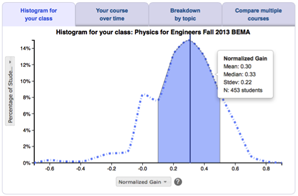
Developed by: Wolfgang Christian






middle schoolhigh schoolintro collegeinter-mediateupper levelgrad school other

calc based

alg based

conceptual











Overview
What? Small, flexible, educational physics applets using simple graphics to convey only salient features of physical phenomena; Modifiable and adaptable, they are designed for use in quizzes, homework problems, and Just in Time Teaching activities. Appropriate for almost any curriculum or teaching style.
Why? They are free and easy to incorporate into nearly any teaching environment or style. Because Physlets are designed to illustrate one focused concept or idea, students don't get distracted or tempted to click on an array of tools. Many are supported with supplementary problem sets and explanations.
Why not? Physlets are do not stand alone and work best to support an existing curriculum. If your goal is for your students to learn to use real lab equipment, or if you don't have access to computers, Physlets might nots be the best approach. They can be buggy on mobile devices.
Student skills developed
- Conceptual understanding
- Problem-solving skills
- Using multiple representations
- Lab skills
- Designing experiments
Instructor effort required
- Medium
Resources required
- Projector
- Computers for students
Resources
Teaching Materials
You can access the Physlet Physics 3E and Physlet Quantum Physics 3E interactive texts and instructor's guides, with hundreds of ready-to-run interactive exercises for teaching physics, for free from the Physlets curriculum page on PhysPort.
Research
This is the third highest level of research validation, corresponding to:
- at least 1 of the "based on" categories
- at least 1 of the "demonstrated to improve" categories
- at least 1 of the "studied using" categories
Research Validation Summary
Based on Research Into:
- theories of how students learn
- student ideas about specific topics
Demonstrated to Improve:
- conceptual understanding
- problem-solving skills
- lab skills
- beliefs and attitudes
- attendance
- retention of students
- success of underrepresented groups
- performance in subsequent classes
Studied using:
- cycle of research and redevelopment
- student interviews
- classroom observations
- analysis of written work
- research at multiple institutions
- research by multiple groups
- peer-reviewed publication
References
- M. Belloni and W. Christian, Physlets for Quantum Mechanics, Comp. Sci. Eng. 5 (1), 90 (2003).
- M. Belloni, W. Christian, and A. Cox, Teaching Qualitative Energy-eigenfunction Shape with Physlets, Phys. Teach. 45 (8), 488 (2007).
- M. Belloni, W. Christian, and M. Dancy, Teaching Special Relativity Using Physlets®, Phys. Teach. 42 (5), 284 (2004).
- S. Bonham, J. Risley, and W. Christian, Using Physlets to Teach Electrostatics, Phys. Teach. 37 (5), 276 (1999).
- W. Christian, M. Belloni, F. Esquembre, B. Mason, L. Barbato, and M. Riggsbee, The Physlet Approach to Simulation Design, Phys. Teach. 53 (7), 419 (2015).
- W. Christian, M. Belloni, D. Sokolowska, A. Cox, and M. Dancy, Teaching with Physlets, Phys. Educ. 55 (4), (2020).
- A. Cox, M. Belloni, and W. Christian, Teaching Physics with Physlet®-Based Ranking Task Exercises, Phys. Teach. 43 (9), 587 (2005).
- M. Dancy, W. Christian, and M. Belloni, Teaching with Physlets®: Examples From Optics, Phys. Teach. 40 (8), 494 (2002).
- K. Lee, G. Nicoll, and D. Brooks, A Comparison of Inquiry and Worked Example Web-Based Instruction Using Physlets, J. Sci. Educ. Tech. 13 (1), 81 (2004).






